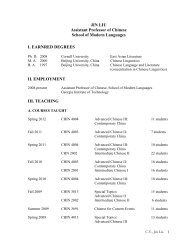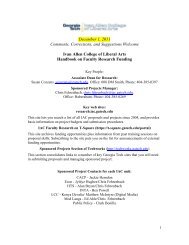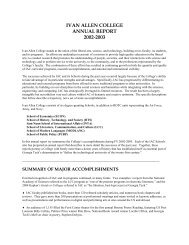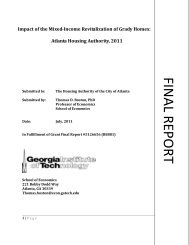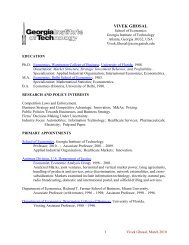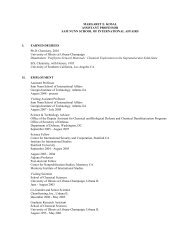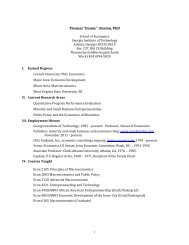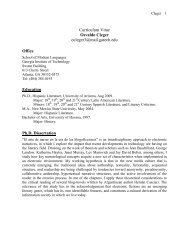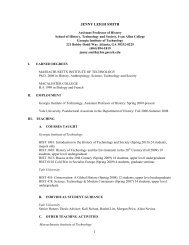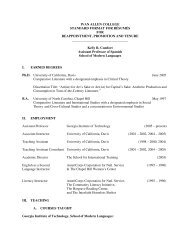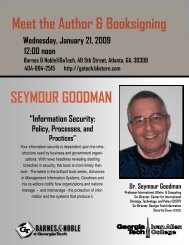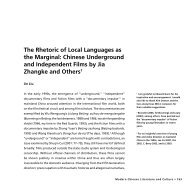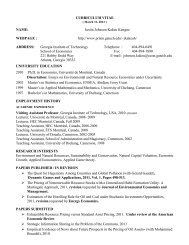IAML and GEML Serve as Models for Foreign Language Study
IAML and GEML Serve as Models for Foreign Language Study
IAML and GEML Serve as Models for Foreign Language Study
You also want an ePaper? Increase the reach of your titles
YUMPU automatically turns print PDFs into web optimized ePapers that Google loves.
Testimony of Diane W. Birckbichler, Director, <strong>Foreign</strong> <strong>Language</strong> Center <strong>and</strong> Chair.<br />
Department of French <strong>and</strong> Italian, The Ohio State University<br />
Subcommittee on Oversight of Government Management, the Federal Work<strong>for</strong>ce,<br />
<strong>and</strong> the District of Columbia of the Committee on Homel<strong>and</strong> Security <strong>and</strong><br />
Governmental Affairs, United States Senate<br />
Lost in Translation: A Review of the Federal Government's Ef<strong>for</strong>ts to Develop a<br />
<strong>Foreign</strong> <strong>Language</strong> Strategy.<br />
Introduction<br />
January 25, 2007<br />
Chairman Akaka, Ranking Member Voinovich, distinguished members of the<br />
subcommittee <strong>and</strong> guests. I want to thank you <strong>for</strong> holding this hearing dealing with<br />
the federal government’s ef<strong>for</strong>ts to develop our national capacity in <strong>for</strong>eign<br />
languages. I am particularly ple<strong>as</strong>ed to be able to discuss these issues in a national<br />
context but also to provide concrete examples of positive <strong>and</strong> productive outcomes<br />
of current federal <strong>and</strong> state legislation, particularly at Ohio State University, a<br />
university with a strong commitment to internationalizing its curriculum <strong>and</strong><br />
showc<strong>as</strong>ing <strong>for</strong>eign languages. I am testifying in my capacity <strong>as</strong> Director of OSU’s<br />
<strong>Foreign</strong> <strong>Language</strong> Center <strong>and</strong> Chair of the Department of French <strong>and</strong> Italian <strong>and</strong><br />
bring with me over 40 years of experience in the field of <strong>for</strong>eign languages <strong>as</strong> a<br />
teacher <strong>and</strong> <strong>as</strong> an administrator. I am p<strong>as</strong>t president of the American Council on the<br />
Teaching of <strong>Foreign</strong> <strong>Language</strong>s <strong>and</strong> have been principal (or co-principal) investigator<br />
of multiple federal <strong>and</strong> state grants.<br />
The title of this panel, Lost in Translation, is a particularly apt <strong>and</strong> rich concept <strong>and</strong> is<br />
well suited <strong>for</strong> deliberations of this sort. It refers to an excellent article by Katherine<br />
McIntire Peters, which appeared in the Government Executive Magazine (check<br />
source) in 2002. The author points first to the experience of Robert Baer who w<strong>as</strong><br />
unable to find speakers of P<strong>as</strong>hto <strong>and</strong> Dari who could collect in<strong>for</strong>mation from the<br />
many refugees that were pouring into Tajikistan from Afghanistan <strong>and</strong> then describes<br />
the difficulties that many federal agencies have in recruiting qualified speakers of<br />
other languages. However, lost in translation provides other insights into discussions<br />
of the need to build our national capacity in <strong>for</strong>eign languages. It can refer to the<br />
mistranslations of words <strong>and</strong> concepts on road <strong>and</strong> street signs that amuse us, but<br />
which when applied at the diplomatic level become much more serious in nature. As<br />
noted on the University of Michigan’s <strong>for</strong>eign language website, “ Those who have<br />
m<strong>as</strong>tered the nuances of a second language are keenly aware how much gets “lost in<br />
translation” <strong>and</strong> that what is lost is often the most crucial point.” The purpose of<br />
my comments is to bring the perspective of higher education to today’s discussion<br />
<strong>and</strong> to join with you in ensuring that our collective message does not get lost in<br />
translation.<br />
We are <strong>for</strong>tunate at this point in time to be able to state with some certainty that<br />
there is widespread acceptance of the value of <strong>for</strong>eign languages; such support<br />
manifests itself in common underst<strong>and</strong>ings such <strong>as</strong> the following: 1) Our nation’s<br />
security, political, <strong>and</strong> economic interests are well served by a nation equipped with<br />
<strong>for</strong>eign language skills; 2) <strong>Foreign</strong> language skills are useful in the international<br />
arena but also domestically <strong>and</strong> go far in promoting intercultural underst<strong>and</strong>ing; 3)<br />
We need a federal <strong>and</strong> private work<strong>for</strong>ce prepared <strong>for</strong> <strong>and</strong> ready to compete in the
2<br />
global marketplace; proficiency in a <strong>for</strong>eign language or languages needs to be an<br />
essential component of the professional toolkit of our undergraduates; 4) The federal<br />
government is promoting <strong>for</strong>eign language study through the work of subcommittees<br />
such <strong>as</strong> this one, through many new <strong>and</strong> long-st<strong>and</strong>ing federal grant opportunities,<br />
<strong>and</strong> through small but growing incentives <strong>for</strong> federal employees with <strong>for</strong>eign<br />
language skills; such advocacy is essential in promoting language study; 5) Our<br />
discourse about <strong>for</strong>eign languages h<strong>as</strong> moved beyond discussions of the b<strong>as</strong>ic skills<br />
acquired through a <strong>for</strong>eign language requirement to conversations about the need<br />
<strong>for</strong> longer <strong>for</strong>eign language sequences in order to develop individuals with advanced<br />
language skills, a process that requires long-term commitments on the part of the<br />
student <strong>and</strong> long-term financial commitments by national, state, <strong>and</strong> local<br />
authorities; <strong>and</strong> 6) Few would disagree that the immersion experiences provided<br />
through study abroad <strong>and</strong> the experience of “living <strong>and</strong> working” in another language<br />
<strong>and</strong> culture are essential to improving our national language capacity.<br />
Changes in language teaching <strong>and</strong> learning<br />
Over the p<strong>as</strong>t several decades, we have seen dramatic changes in the ways in which<br />
<strong>for</strong>eign languages are learned <strong>and</strong> taught. These changes are reflected in our<br />
national discourse about language learning, in our discussions of establishing local,<br />
state <strong>and</strong> national <strong>for</strong>eign language policies, in the production of cl<strong>as</strong>sroom<br />
textbooks, print, <strong>and</strong> multimedia materials, <strong>and</strong> in day-to-day teaching <strong>and</strong> learning<br />
strategies in the cl<strong>as</strong>sroom. Many examples illustrate this point. For instance,<br />
cl<strong>as</strong>srooms once characterized by grammar translation some years ago <strong>and</strong> in the<br />
60s by dialogue memorization have been replaced with practical, per<strong>for</strong>mance-b<strong>as</strong>ed<br />
curricula. Today’s <strong>for</strong>eign language programs <strong>and</strong> courses are characterized in terms<br />
of proficiency outcomes; curriculum development can be in<strong>for</strong>med by the National<br />
St<strong>and</strong>ards <strong>for</strong> <strong>Foreign</strong> <strong>Language</strong> Learning (http://www.actfl.org) <strong>and</strong> the 5 Cs<br />
embedded in them (Communication, Culture, Comparisons, Communities <strong>and</strong><br />
Connections) <strong>as</strong> well <strong>as</strong> current research on how languages are used in other<br />
cultures <strong>and</strong> countries.<br />
New curricular initiatives<br />
A recent article in Inside Higher Education<br />
(http://insidehighered.com/news/2007/01/02/languages) entitled “Dramatic Plan <strong>for</strong><br />
<strong>Language</strong> Programs” also reflects the changes taking place in <strong>for</strong>eign language<br />
study, in this c<strong>as</strong>e indicating a movement away from a primary literary emph<strong>as</strong>is in<br />
undergraduate major <strong>and</strong> minor programs to an approach that includes are<strong>as</strong> such<br />
<strong>as</strong> history, culture, economics, <strong>and</strong> m<strong>as</strong>s media. The article describes the report of a<br />
panel convened by the Modern <strong>Language</strong> Association, a report that is still being<br />
reviewed by the organization but which w<strong>as</strong> discussed in a briefing at this year’s MLA<br />
meeting in Philadelphia. Although the re<strong>for</strong>ms grew out of educational concerns,<br />
some panel members felt that the new emph<strong>as</strong>es would produce graduates whose<br />
expertise would be more useful to the government, business, <strong>and</strong> education than<br />
those of current graduates. The MLA panel mentions two exemplary programs:<br />
Georgetown University’s German program<br />
(http://www3.georgetown.edu/departments/german/programs/curriculum/), which<br />
focuses on multiple literacies <strong>and</strong> New York University’s Latin American Studies<br />
program (http://www.nyu.edu/gs<strong>as</strong>/program/latin/).<br />
Interestingly, although such a report is welcomed <strong>and</strong> indicative of substantial<br />
change, many postsecondary institutions, whether two-year or four-year, have
3<br />
already established majors or tracks that emph<strong>as</strong>ize a more cultural approach to<br />
language study. For example, many programs offer students a series of<br />
undergraduate options. Students in the French program at OSU can choose among<br />
the following tracks: French language <strong>and</strong> culture, French language <strong>and</strong> literature,<br />
French <strong>for</strong> the professions, <strong>and</strong> a more general French Studies Track. Students who<br />
minor in French also have options (film/culture, language, literature, business, <strong>and</strong><br />
French studies). These tracks are popular with students who take seriously the<br />
option of tailoring their major <strong>and</strong> minor to their personal <strong>and</strong> professional goals.<br />
Many programs offer business or professional courses or tracks <strong>for</strong> students. Others<br />
offer business internship programs that combine discipline-specific work <strong>and</strong> <strong>for</strong>eign<br />
languages. The long-st<strong>and</strong>ing International Engineering Program at the University of<br />
Rhode Isl<strong>and</strong> (http://www.uri.edu/iep/) is an excellent example of this type of<br />
cooperative venture. Originally offered in German, the program h<strong>as</strong> now exp<strong>and</strong>ed<br />
to include French <strong>and</strong> Spanish (<strong>and</strong> will soon add Chinese) <strong>and</strong> offers students the<br />
opportunity to obtain two degrees, become fluent in a language, <strong>and</strong> participate in<br />
an internship abroad with one of the program’s corporate partners. Georgia Tech<br />
provides other examples of innovative undergraduate degrees. Their Bachelor of<br />
Science degree in Global Economics & Modern <strong>Language</strong>s<br />
(http://www.iac.gatech.edu/degrees/iaml.htm) combines rigorous training in<br />
economics with extensive <strong>for</strong>eign language study. The separate language<br />
concentrations include Chinese, French, German, Japanese, <strong>and</strong> Spanish. A B.S. in<br />
International Affairs <strong>and</strong> Modern <strong>Language</strong>s is also available<br />
(http://www.iac.gatech.edu/degrees/iaml.htm/).<br />
These are but a few of the examples that illustrate innovative undergraduate<br />
programs designed to prepare students in a discipline but also to provide high levels<br />
of language proficiency that would allow the individual to interact socially <strong>and</strong><br />
professionally in his or her second language. Such programs prepare graduates <strong>for</strong><br />
the types of jobs available in both the public <strong>and</strong> private sector.<br />
Advanced skills <strong>and</strong> media<br />
In today’s world, advanced skills, <strong>for</strong>merly introduced to students primarily through<br />
the literature of a culture, take on new meanings in light of the accessibility of<br />
in<strong>for</strong>mation <strong>and</strong> new technologies. Nations <strong>and</strong> societies are able to present<br />
themselves <strong>and</strong> their stories instantly to a worldwide audience in print, audio, <strong>and</strong><br />
visual media. These stories are always conveyed by the different media that are<br />
characteristic of each society—whether print, television, newspaper, Internet, or<br />
community gossip. Technology today allows us almost instant access—both real<br />
<strong>and</strong> virtual--to these <strong>for</strong>merly inaccessible media through satellite broadc<strong>as</strong>ting, the<br />
Internet, <strong>and</strong> through h<strong>and</strong>-held technologies such <strong>as</strong> the iPod <strong>and</strong> cell phones,<br />
which are becoming incre<strong>as</strong>ingly versatile <strong>and</strong> multimedia-ready (a prime example is<br />
Apple’s new Iphone). The challenge <strong>for</strong> us is to know how to use that access<br />
intelligently <strong>and</strong> to integrate modern media into the instruction <strong>and</strong> learning of<br />
<strong>for</strong>eign languages <strong>and</strong> cultures. It is becoming incre<strong>as</strong>ingly clear that advanced<br />
language skills are to a large extent dependent upon the ability to access the media<br />
of another culture <strong>and</strong> to interpret, evaluate, <strong>and</strong> use the in<strong>for</strong>mation gained to<br />
achieve one’s goals—whether interpersonal or professional. Thus, initiatives such <strong>as</strong><br />
OSU’s World Media <strong>and</strong> Culture Center (http://wmcc.osu.edu) puts access to the<br />
media of the world at the core of the language curriculum. The media-rich<br />
curriculum of OSU’s Chinese Flagship program (http://www.chineseflagship.org/)<br />
adds to the current FSI/ILR <strong>and</strong> ACTFL metrics definition of advanced skills; it
4<br />
includes the ability to participate in the major media of China (e.g., interpreting oral<br />
<strong>and</strong> written media, discussing them in culturally appropriate ways, <strong>and</strong> creating<br />
presentations in these media <strong>for</strong> target-culture presentations). The OSU Chinese<br />
Flagship Program h<strong>as</strong> also developed an electronic portfolio system that incorporates<br />
the students’ interaction with various Chinese media into a transparent <strong>as</strong>sessment<br />
tool. Such a system requires the program to elicit language per<strong>for</strong>mances from its<br />
students <strong>and</strong> presents them to a variety of interested observers.<br />
Positive effects of federally funded programs<br />
The language community applauds the federal government’s continued funding of<br />
long-st<strong>and</strong>ing programs (Title VI funding, Fulbright <strong>Study</strong> Abroad programs) <strong>and</strong> of<br />
newer initiatives (National Security <strong>Language</strong> Initiative, National Flagship Programs),<br />
all of which when viewed together comprise an integrated approach to developing<br />
our nation’s capacity in <strong>for</strong>eign languages <strong>and</strong> have greatly benefited recipients of<br />
this funding, whether institutional or individual. In his 2005 testimony to the<br />
Committee on House Education <strong>and</strong> Work<strong>for</strong>ce Subcommittee on Select Education<br />
chaired by Representative Pat Tiberi, Jerry Ladman, at that time Associate Provost,<br />
International Affairs at OSU outlined the significant benefits accrued through the<br />
various Title VI-funded Area Studies Centers <strong>and</strong> the National E<strong>as</strong>t Asian <strong>Language</strong>s<br />
Resource Center; he described how this funding w<strong>as</strong> used to leverage internal<br />
support of language <strong>and</strong> culture studies <strong>and</strong> curricula at OSU, to incre<strong>as</strong>e<br />
interdisciplinary research both within <strong>and</strong> across regions, to strengthen library<br />
holdings, <strong>and</strong> to incre<strong>as</strong>e P-12 outreach ef<strong>for</strong>ts. Title VI funding of the OSU National<br />
<strong>Language</strong> Resource Center <strong>and</strong> the National E<strong>as</strong>t Asian <strong>Language</strong>s Resource Center<br />
w<strong>as</strong> instrumental in the development, conceptualization <strong>and</strong> funding of the OSU’s<br />
leading-edge World Media <strong>and</strong> Culture Center referred to earlier in this testimony.<br />
OSU h<strong>as</strong> benefited significantly from the federal funding provided through the<br />
National Security Education Program which sponsors our Chinese Flagship Program<br />
<strong>and</strong> its P-12 Chinese Pipeline Project. In addition, this funding h<strong>as</strong> been leveraged to<br />
attract two major projects funded by the State of Ohio (<strong>for</strong>mer Governor Robert<br />
Taft's Core Curriculum <strong>for</strong> the State of Ohio) <strong>for</strong> an alternative licensure program <strong>for</strong><br />
teachers of Chinese <strong>and</strong> Japanese <strong>and</strong> <strong>for</strong> a Board of Regents' Chinese Summer<br />
Academy. The OSU Chinese Flagship Program h<strong>as</strong> also entered into cooperation with<br />
the Ohio Department of Education to build the infr<strong>as</strong>tructure <strong>for</strong> mainstreaming<br />
Chinese language instruction in schools throughout Ohio. <strong>and</strong> is working with that<br />
office to develop P-12 curriculum in Chinese <strong>as</strong> part of a <strong>Foreign</strong> <strong>Language</strong><br />
Assistance Program grant awarded to ODE <strong>for</strong> the development of a P-6 Chinese<br />
curriculum.<br />
The undergraduate <strong>and</strong> graduate fellowships provided through the National Security<br />
Education program have been instrumental in providing longer-term study abroad<br />
opportunities <strong>for</strong> our graduate <strong>and</strong> undergraduate students in countries where critical<br />
languages are spoken, <strong>and</strong> through longer-term study abroad opportunities, students<br />
indeed have the opportunity to develop advanced-level skills in these languages.<br />
The Fund <strong>for</strong> the Improvement of Postsecondary Education organized in the early<br />
90s a competition to fund collaborations between high school <strong>and</strong> universities in the<br />
area of <strong>for</strong>eign languages. OSU received one of these grants <strong>and</strong> through it<br />
established the Collaborative Articulation <strong>and</strong> Assessment Project<br />
(http://caap.osu.edu). This partnership between higher education <strong>and</strong> Ohio public<br />
schools w<strong>as</strong> designed to improve the articulation between high school <strong>and</strong> college
5<br />
language study. I mention this project here not only because of the importance of<br />
such collaborative ef<strong>for</strong>ts but also to demonstrate the longevity of many programs<br />
originally seeded by a federal grant. CAAP, now funded by OSU <strong>and</strong> the Ohio Board<br />
of Regents, continues to grow <strong>and</strong> to be instrumental in helping smooth the<br />
transition between levels.<br />
Another federally funded initiative needs to be mentioned at this point. The<br />
Partnership <strong>for</strong> Public Service (http://www.ourpublicservice.org/), which <strong>as</strong> the<br />
members of this committee know, w<strong>as</strong> designed to serve <strong>as</strong> an interface between<br />
federal employers <strong>and</strong> the academic community. An excellent example of<br />
collaborative ef<strong>for</strong>ts of a non-profit organization, the federal government, <strong>and</strong> the<br />
academic community, the Partnership h<strong>as</strong> <strong>as</strong> its stated purpose “to make the<br />
government an employer of choice <strong>for</strong> talented, dedicated Americans through<br />
educational outreach, research, legislative advocacy, <strong>and</strong> h<strong>and</strong>s-on partnerships with<br />
agencies on work<strong>for</strong>ce management issues”. Although its mission is larger than<br />
<strong>for</strong>eign languages, OSU served <strong>as</strong> one of the Partnership’s pilot schools <strong>and</strong> w<strong>as</strong> able<br />
to include <strong>for</strong>eign languages <strong>as</strong> one of OSU’s emph<strong>as</strong>es. Because of its collaborative<br />
relationship with the Partnership, the OSU <strong>Foreign</strong> <strong>Language</strong> Center h<strong>as</strong> been able to<br />
establish connections with many federal agencies that seek employees with language<br />
skills <strong>and</strong> bring these opportunities to our students’ attention. This initiative h<strong>as</strong><br />
greatly enhanced our capacity to make career connections <strong>for</strong> our students in<br />
languages <strong>and</strong> to contribute to a language-ready federal work <strong>for</strong>ce. Because of our<br />
connections with the Partnership, we hosted a highly successful <strong>Foreign</strong> <strong>Language</strong><br />
Career Day in the spring of 2006 attended by over 200 students <strong>and</strong> representatives<br />
from ten federal agencies.<br />
These are but a few examples of how federal funding h<strong>as</strong> made significant<br />
contributions to our language <strong>and</strong> culture missions at OSU <strong>and</strong> I am sure that other<br />
colleges <strong>and</strong> universities could tell similar success stories to further emph<strong>as</strong>ize the<br />
important role that federal funding plays in building <strong>and</strong> sustaining <strong>for</strong>eign language<br />
initiatives. As w<strong>as</strong> noted earlier, federal support is but one component of the funding<br />
of <strong>for</strong>eign language <strong>and</strong> culture study; it is, however, instrumental in leveraging<br />
monies from internal sources, from state sources of funding, <strong>and</strong> from private<br />
foundations.<br />
<strong>Foreign</strong> <strong>Language</strong>s at the Core: A Meat <strong>and</strong> Potatoes Approach<br />
Many voices at the national level are calling <strong>for</strong> incre<strong>as</strong>ed <strong>for</strong>eign language study,<br />
incre<strong>as</strong>ed internationalization of the curriculum, <strong>and</strong> expansion of the <strong>for</strong>eign<br />
language pipeline in the nation’s elementary <strong>and</strong> secondary schools. Clearly, the<br />
federal government h<strong>as</strong> been instrumental in changing the discourse regarding<br />
<strong>for</strong>eign languages through its expansion of federal funding <strong>for</strong> <strong>for</strong>eign languages <strong>and</strong><br />
through the attention brought to the need <strong>for</strong> <strong>for</strong>eign language study by House <strong>and</strong><br />
Senate committees t<strong>as</strong>ked with working with the academic, business, <strong>and</strong> public<br />
sectors on <strong>for</strong>eign language issues.<br />
Other voices are weighing in on the need <strong>for</strong> <strong>for</strong>eign languages. For example, the<br />
report of the Committee on Economic Development (www.ced.org), represented at<br />
today’s hearing <strong>and</strong> warmly welcomed by the <strong>for</strong>eign language community, called <strong>for</strong><br />
exp<strong>and</strong>ing international content <strong>and</strong> <strong>for</strong> exp<strong>and</strong>ing the <strong>for</strong>eign language training<br />
pipeline to incre<strong>as</strong>e the number of speakers of other languages, especially the critical<br />
languages. The American Council on Education (http://www.acenet.edu) called on<br />
colleges <strong>and</strong> universities “to make <strong>for</strong>eign language competence an integral part of
6<br />
a college education” <strong>and</strong> to ensure that “every baccalaureate holder…be competent<br />
in a second language.” In a similar vein, the Association of American Colleges <strong>and</strong><br />
Universities (www.aacu.org/) characterized the ability to communicate in another<br />
language <strong>as</strong> “one of the fundamental skills that define “empowered learners.” The<br />
report of National Association of State Boards of Education report entitled “The<br />
Complete Curriculum: Ensuring a place <strong>for</strong> the arts <strong>and</strong> <strong>for</strong>eign languages in<br />
America’s schools” (http://www.n<strong>as</strong>be.org/) <strong>and</strong> Global Competence & National<br />
Needs, report of the Commission on the Abraham Lincoln <strong>Study</strong> Abroad Fellowship<br />
Program (www.lincolncommission.org) provide additional support <strong>for</strong> language study<br />
<strong>and</strong> in the c<strong>as</strong>e of the latter study abroad. These are but a sampling of current<br />
reports from national organizations <strong>and</strong> commissions pointing to the value of<br />
language study.<br />
At the state <strong>and</strong> local levels, conversations about the value of <strong>for</strong>eign languages are<br />
becoming more prevalent. A Columbus Dispatch editorial (January 15, 2006) stated<br />
that “The old arguments in favor of learning <strong>for</strong>eign languages are still valid. It’s an<br />
excellent intellectual exercise, in many c<strong>as</strong>es enhances the learner’s appreciation of<br />
the grammar <strong>and</strong> structure of his own native language, <strong>and</strong> helps the learner<br />
underst<strong>and</strong> more about the world.” But it is the Dispatch’s take on the “new<br />
argument” <strong>for</strong> <strong>for</strong>eign languages that captures one’s interest: “The new argument—<br />
that once obscure nations <strong>and</strong> cultures can affect the lives of Americans dramatically,<br />
so Americans need to underst<strong>and</strong> them better—is even more compelling.” Robert<br />
Taft, <strong>for</strong>mer governor of Ohio, called <strong>for</strong> a bold plan to incre<strong>as</strong>e high school<br />
graduation requirements; in addition to incre<strong>as</strong>es in math <strong>and</strong> science requirements,<br />
two years of <strong>for</strong>eign language were to be added. In lieu of a yes or no on the <strong>for</strong>eign<br />
language component of the bill, the legislature <strong>as</strong>ked <strong>for</strong> the creation of the <strong>Foreign</strong><br />
<strong>Language</strong> Advisory Council in Ohio SB 311 to devise an implementation plan <strong>for</strong> K-12<br />
language instruction.<br />
Even with positive attitudes toward <strong>for</strong>eign language study incre<strong>as</strong>ingly articulated in<br />
public <strong>for</strong>ums, languages are still not considered a staple in the US curriculum. The<br />
re<strong>as</strong>ons vary but are illustrated by comments such <strong>as</strong> the following: A<br />
superintendent of a Midwestern school district w<strong>as</strong> quoted <strong>as</strong> saying that he would<br />
rather see federal funds go to meat-<strong>and</strong>-potatoes subjects. Another w<strong>as</strong> concerned<br />
that there w<strong>as</strong> not enough room <strong>for</strong> <strong>for</strong>eign languages in the curriculum. Still others<br />
at the university level worry that students from the sciences, engineering, <strong>and</strong><br />
business must meet incre<strong>as</strong>ingly large numbers of requirements imposed by their<br />
professional organizations, thus those making curricular decisions continue to <strong>as</strong>sert<br />
that there is not enough time <strong>for</strong> <strong>for</strong>eign languages in the curriculum.<br />
Despite the clear <strong>and</strong> strong support from the federal government <strong>and</strong> from various<br />
educational organizations, the <strong>for</strong>eign language community <strong>and</strong> its advocates have<br />
an important t<strong>as</strong>k ahead of them, one recognized by the Committee <strong>for</strong> Economic<br />
Development, which suggested a public relations campaign. That t<strong>as</strong>k is to lobby to<br />
have <strong>for</strong>eign languages included in the core curriculum <strong>and</strong> to make the c<strong>as</strong>e that<br />
languages are an essential part of the b<strong>as</strong>ic skills set needed by a graduate (high<br />
school or college) who wants to compete in the global economy. <strong>Foreign</strong> languages<br />
need to be universally seen <strong>as</strong> meat <strong>and</strong> potatoes, an integrated part of the core<br />
curriculum, not just a t<strong>as</strong>ty dessert.<br />
Conclusion
7<br />
Higher education h<strong>as</strong> already begun to respond to the t<strong>as</strong>k of preparing a global<br />
ready language citizen equipped with language <strong>and</strong> culture skills <strong>and</strong> much progress<br />
h<strong>as</strong> been made in the l<strong>as</strong>t several decades. This progress is in part due to initiatives<br />
sponsored by the federal government <strong>and</strong> in part due to state- <strong>and</strong> universityspecific<br />
initiatives to advance the cause of <strong>for</strong>eign languages such <strong>as</strong> those described<br />
in this testimony. With new curricula, state <strong>and</strong> federal support, the advocacy of<br />
the major organizations such <strong>as</strong> the Committee <strong>for</strong> Economic Development, the<br />
<strong>for</strong>eign language <strong>and</strong> international education community acknowledges that much<br />
work needs to be done to create a language-ready work<strong>for</strong>ce <strong>for</strong> the future. We are<br />
ready to work with public <strong>and</strong> private entities to incre<strong>as</strong>e our capacity in languages<br />
<strong>and</strong> to encourage advanced language skill development. I would suggest the<br />
following <strong>as</strong> are<strong>as</strong> that need attention:<br />
• Continued emph<strong>as</strong>is on the development of K-16 partnerships (e.g., Flagship<br />
K-16 pipeline <strong>and</strong> federal <strong>and</strong> state funding <strong>for</strong> such initiatives, perhaps a<br />
revival of the FIPSE-sponsored <strong>for</strong>eign language articulation grants);<br />
• Continued funding of longer language sequences which will lead to the<br />
development of advanced language skills through the National Flagship<br />
program which focuses on level 3 skills <strong>as</strong> defined by the FSI <strong>and</strong> the creation<br />
of other initiatives that support longer sequences in both commonly <strong>and</strong> less<br />
commonly taught languages;<br />
• Continued funding of programs that develop a core of qualified language<br />
teachers (particularly in the critical languages where a teacher infr<strong>as</strong>tructure<br />
needs to be established) so that teachers will be available to staff longer<br />
sequences of language instruction <strong>as</strong> they are implemented;<br />
• The development of exchange programs with other countries where their<br />
young people can live <strong>and</strong> study in our country <strong>and</strong> our youth can live <strong>and</strong><br />
study in their countries <strong>for</strong> long enough periods of time to develop solid<br />
language skills.<br />
• Recognition that a strong language infr<strong>as</strong>tructure <strong>for</strong> all language programs<br />
not just the critical languages is essential <strong>for</strong> language learning in the US.<br />
• Continued advocacy <strong>for</strong> <strong>for</strong>eign languages by the federal <strong>and</strong> state<br />
governments, educational <strong>and</strong> business organizations to make <strong>for</strong>eign<br />
languages part of the core curriculum <strong>and</strong> one of our b<strong>as</strong>ic educational skills;<br />
• A recognition that an international curriculum must include a substantial<br />
<strong>for</strong>eign language component;<br />
• Development of a national language policy <strong>and</strong> the establishment of language<br />
policies at the state level <strong>as</strong> well; <strong>and</strong><br />
• Continued encouragement <strong>and</strong> federal support <strong>for</strong> study abroad programs<br />
where language <strong>and</strong> culture skills are integral to the program.<br />
Thank you <strong>for</strong> giving me the opportunity to testify <strong>and</strong> to share these views with you<br />
<strong>and</strong> the subcommittee.



